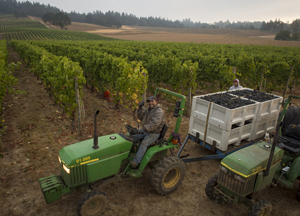| MOG Blog |
|
Rutherford, Calif.—During my interview with Philippe Bascaules, managing director and winemaker at Inglenook winery and the former director of Chateau Margaux, we covered a lot of ground discussing the changes he’s made since joining the historic Rutherford winery in 2011.
I couldn’t fit everything in the piece that we published on the main page of the website before the holiday weekend, and so I thought I’d post a few extra details and insights here on the blog.
While Wines & Vines doesn’t review wines, I can say without a doubt that the few wines I tasted with Bascaules are an improvement from what I’ve tasted previously at Inglenook. I tried the 2012 Rubicon, which is the current release by the winery, and a barrel sample of the 2014 Rubicon. Both have achieved Bascaules’ goal of maintaining balance retaining the richness and power of Napa Valley.
On a fittingly hot day in Davis, Calif. in late July — I think the temperature hit 104 degrees that afternoon — I attended a session on using heat in winemaking.
The subject of the day wasn’t just heat, but the more involved process that’s called flash détente in France. We’ve reported on the growth of flash in California and the United States (Here's a good article by Laurie Daniel), but what struck me at the event in Davis is that American winemakers are now beginning to use the process regularly rather than just as a means to fix a problem or remove a specific taint. The process involves heating grapes to 180 to 190 F and transferring them into a vacuum chamber.
Portland, Ore.—The 2014 wine grape harvest in Oregon set a new record at a little more than 78,000 tons, which is 39% more than the previous year.
2014 was the third consecutive year in which the state saw double-digit gains in its production of grapes, according to the Oregon Vineyard and Winery Census Report released by the Oregon Wine Board.

For many growers in the Midwest and eastern North America, this past winter was another tough one in which cold temperatures killed young buds and vines. Bob Thaden, the winemaker and owner of Tongue River Winery in Miles City, Mont., is one of those vintners. In December 2013, temperatures hit -40° F, and that was followed by a hard, late-spring frost in 2014 and the earliest fall frost he’d seen in 25 years on Sept. 12, 2014. “So the already weakened vines were not hardened off well at all last fall, and our Marquette mostly died back to the ground a second year in a row,” he told me in an email. “Everything looks really good for next year, provided that we have a friendly fall, winter and spring! We’d certainly like another crop of Marquette.”
More than 1,500 firefighters with 157 fire engines, 13 helicopters and 35 dozers are battling the Wragg Fire near Lake Berryessa on the border of Napa and Solano counties, just west of the small town of Winters, Calif. (Photo from ABC7 News.)
A few structures have been damaged in the fire, which also triggered some residential evacuations orders that have since been lifted. Located in a fairly remote and rugged area, the fire is not threatening any vineyards so far, but it is generating a significant amount of smoke at a time when many vineyards in Napa and Solano counties are just beginning to see color, or are well into véraison, when the grapes are particularly sensitive to smoke taint.
- Portraits in cork 07.07.2017
- Did you learn the lessons of the Napa earthquake? 06.08.2017
- Bucking the $10 and up premiumization trend 06.05.2017
- Wine in cans, not the next Moscato 05.31.2017
- Sparkling Tour Wraps in Santa Rosa 05.30.2017
- Three Livermore Wineries to Release White Blend 05.02.2017
- More than just the Chardonnay at Rombauer 09.27.2016
- Fewer varieties and less buses at the new Viansa 08.12.2016
- 25th Anniversary WIFS to feature several industry experts 08.03.2016
- Water Insights from the ASEV Conference 07.25.2016
- Post Your Support for New UC Extension Staff 06.20.2016
- Rack & Riddle Invests in the Riddling 05.20.2016





